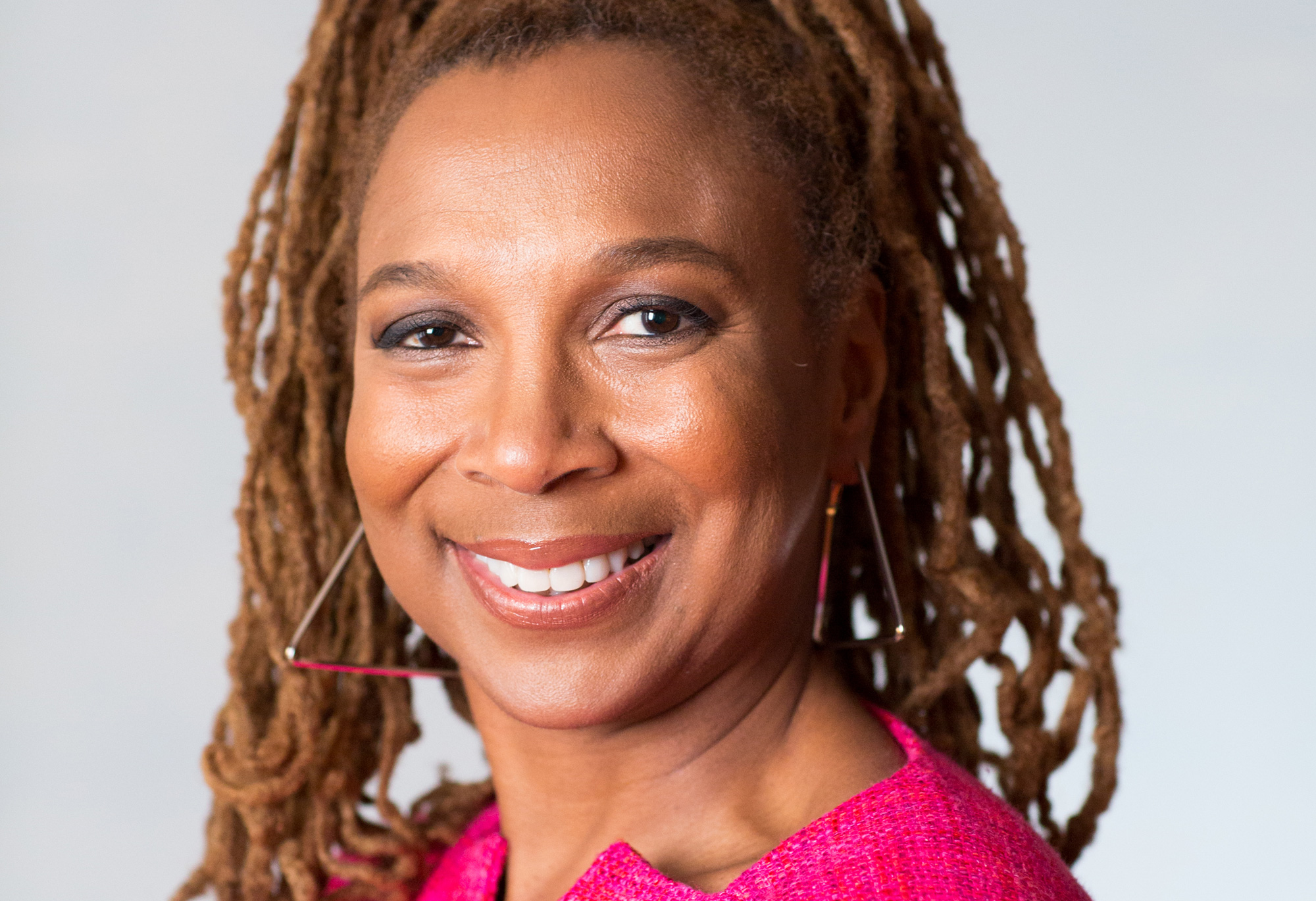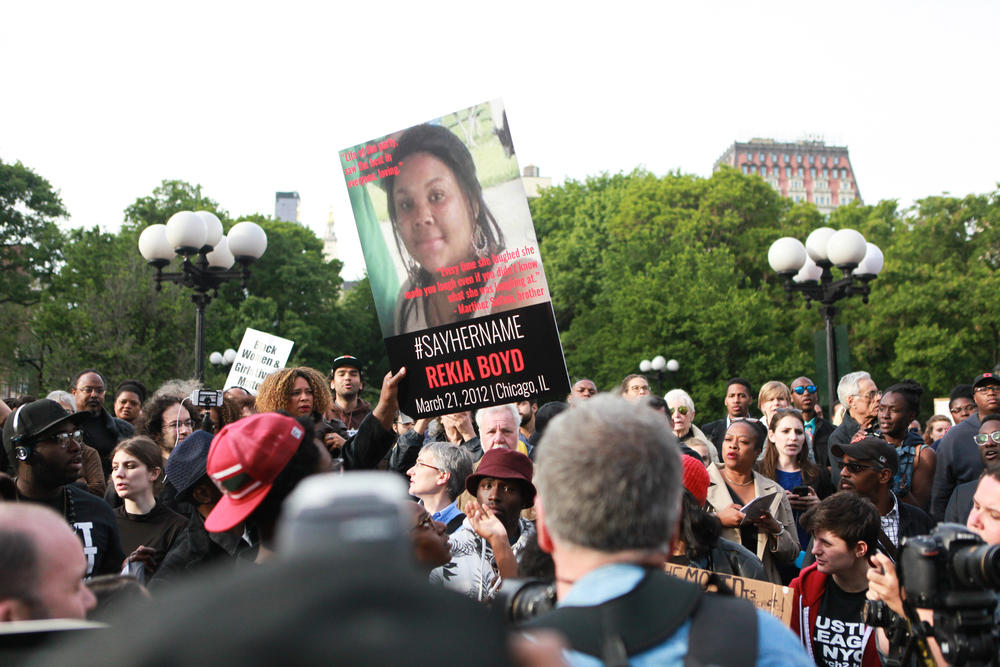
A law professor and the founder and director of Columbia’s Center for Intersectionality and Social Policy Studies (CISPS), Kimberlé Crenshaw is a leading authority on civil rights, Black feminist legal theory, and race, racism, and the law. In 2015, she helped create the Say Her Name movement to call attention to police violence against Black women. We sat down with Crenshaw to learn more about her efforts to highlight the challenges facing women and girls of color.
You and your colleagues at CISPS and the nonprofit African American Policy Forum (AAPF) helped create the Say Her Name movement. Can you tell us more about it?
Say Her Name is an effort to challenge the way we think and talk about racial justice so that it becomes far more gender-inclusive. We were inspired to start Say Her Name while protesting the Eric Garner grand-jury decision. Protesters were calling out the names of Black men who had been killed by the police, but Black women who had died in similar circumstances were not mentioned. We began saying the names of these Black women. We began chanting: Say her name. It soon transformed from a Twitter hashtag into a movement. Our goal is to break the silence around state violence against women of color.
What kind of response have you received?
Some people are surprised to hear that the police kill Black women. Others are really grateful that we have raised these issues. And then there are a few — just a few — who are disturbed by it, because they actually see us as intervening in a way that is undermining the focus on Black men and boys.
What do you say to this argument that including Black women’s experiences in the movement against police brutality undermines the work being done on behalf of Black men?
My colleagues and I would say that we can’t significantly improve the well-being of communities of color without dealing directly with the vulnerabilities that women face. To ignore Black women’s experiences would constitute a deeply tragic misunderstanding of how multiple vulnerabilities get enhanced in relationship to each other. But even if you adopted the male-exclusive approach, you can’t work toward bettering the lives of Black boys, for example, without paying attention to the socioeconomic status of their mothers. In our community, the vast majority of Black children are dependent on their mothers’ income and well-being, and many of those children are living in homes with single Black mothers. Yet Black women are faring worse in the economy than any other group. Clearly, race- and gender-targeted interventions are needed to improve the well-being of Black women, Black families, and Black communities.
Your theory of intersectionality speaks to many of the challenges that Black women face. Tell us about intersectionality.
I first used the term nearly thirty years ago to describe a case where several Black women sued General Motors on the grounds of race and gender discrimination. Though the company had employed Black people and women, the jobs that were available for Blacks were only given to men, and the jobs that were available for women were only given to white women. So, for a long time, the intersection of GM’s race and gender policy had a special impact on Black women, completely excluding them from any of the jobs. The theory of intersectionality is about learning to recognize the multiple vulnerabilities that every person faces, which sometimes set us up for compounded or targeted forms of discrimination. You need to have a sense of the varying ways that people experience social injustice in order to be more inclusive of their realities. Intersectionality theory highlights aspects of discrimination that have historically made it much more difficult for certain people to be seen and for their circumstances to be addressed by the law.
Police brutality is often framed as an injustice against men and boys. What does police violence against women look like?
Sexual misconduct is the second most common form of misconduct reported against law-enforcement officers [according to a 2010 Cato Institute report], and this critical issue also requires our attention. In our Say Her Name report [released by the AAPF and CISPS in May 2015] many women point out that police have no significant constraints around the use of sexual power. In fact, two-thirds of police departments in the United States do not have a single policy that addresses sexual abuse by their officers. Daniel Holtzclaw, a former Oklahoma police officer, was recently convicted of sexually assaulting eight Black women, and while he was ultimately sentenced to 263 years in prison, his conviction should be viewed as the exception rather than the rule. We live in a rape culture: victims are not only blamed for the violence they endure, but their credibility is also attacked. There are untold numbers of socially marginalized women who encounter all forms of sexual violence by law enforcement and have no chance of having their cases heard or prosecuted.
Why do you think Black women’s experiences are pushed to the margins in the movement against police violence?
I think there are a couple of obvious reasons. Black women are not valued. It’s not that the violence is invisible; it’s that it isn’t seen. One horrifying example is the death of Natasha McKenna at the Fairfax County Adult Detention Center. There is a video showing Natasha McKenna being violently extracted from her holding cell, naked, by five sheriff’s deputies in hazmat suits, who then tase her four times in the process of moving her to a restraint chair. It is incredible that this video has prompted very little response across the country. There are other videos showing Black women being beaten on the sides of highways in plain sight, hauled out of car windows, hogtied, and dragged across the floor — grandmothers stripped down and thrown — it’s there for anyone to see. The question is, when it is seen, why doesn’t it become a problem? Why aren’t we incited to say their names?
Your Black Girls Matter report [released by the AAPF and CISPS in February 2015] focuses on the structural inequality that Black girls face. Tell us about your findings.
Our study showed that the disparity in treatment between Black girls and white girls was greater than the disparity in treatment between Black boys and white boys. Around the country, Black boys are three times more likely to be suspended from school than white boys, but Black girls are six times more likely to be suspended than white girls. So race seems to be more salient in the decision to punish Black girls than it is in the decision to punish Black boys. That often gets suppressed and marginalized because there are so many boys in general who get suspended. But it’s important that those differences rise to the surface in our efforts to intervene.
How can your research, reports, and advocacy translate to a change in policy?
My team and I are currently working on a policy strategy with respect to Say Her Name and the sexual abuse of women by police officers. In thinking about interventions, we have to start by looking at the permissive policies and uneven distribution of power that enable the problem. Then we can begin to consider dismantling them and creating another grid of power. We know that leading by example and having a strict, articulable policy really make a difference. Both signal to officers that sexual access is not a perk of their job. So we’re advocating for the development and implementation of a clear set of open procedures and expectations for law-enforcement officers. A key component of our work is building public awareness so that people have the will to address these problems.
More and more college students are involved in racial-justice advocacy. Do you think this reflects a shift in consciousness?
The current shift among students is important, because it represents a repudiation of the effort to suppress ongoing racial-justice issues. Post-racial ideology [the idea that America is colorblind] can’t completely contain the realities that people are experiencing. That is an essential starting position for any effort to make a shift more historically stable. The rate at which students of color are matriculating onto campuses is starting to decline. So student activists really are casting attention to critical issues, and for a lot of folks, these students are heroes.
Black Lives Matter drew a lot of comparisons to the civil-rights movement, and some people felt that it didn’t measure up. What’s your response to this assessment?
The thing that disturbs me the most is assuming that the struggle for racial justice is divided up into separate and distinct movements. That is not how we think of the structural oppression we have been resisting for centuries. There are clearly ebbs and flows and different generational moments in the movement. Ideological differences have always existed among people of the same generation around how to frame the problem, how to mobilize against it, and what should be first on the agenda. But some factors are constant. The role of women in organizing and mobilizing, and their relative absence as subjects of racial injustice, has been continuous. I don’t think any generation can say to the other, you got it right, or you got it wrong. These are debates across our history.
Not Forgotten
Stories of police brutality against Black women from the Say Her Name report
Shereese Francis: Suffocated to death on March 15, 2012, at her home in Queens, New York, as police officers were subduing her during a mental-health crisis
Rekia Boyd: Killed by an off-duty Chicago police officer on March 21, 2012
Sharmel Edwards: Killed by police in Las Vegas on April 21, 2012, while being followed on the suspicion that she was driving a stolen car
Shantel Davis: Killed by a plainclothes detective in East Flatbush, Brooklyn, on June 14, 2012, while unarmed
Malissa Williams: Killed by police in Cleveland on November 29, 2012, after the driver of the car she was riding in refused to pull over
Shelly Frey: Killed by an off-duty sheriff and minister in Houston on December 6, 2012
Kayla Moore: Killed by police in Berkeley, California, on February 12, 2013
Kyam Livingston: Died from a seizure on July 24, 2013, when NYPD officers allegedly left her in a holding cell despite complaints that she was in pain
Miriam Carey: Killed by federal agents in Washington, DC, on October 3, 2013, while with her one-year-old baby
Yvette Smith: Killed by police responding to a domestic-disturbance complaint in Bastrop, Texas, on February 16, 2014
Gabriella Nevarez: Killed by police in Sacramento on March 2, 2014
Pearlie Golden: Killed by police in Hearne, Texas, on May 7, 2014
Michelle Cusseaux: Killed by police in Phoenix on August 13, 2014
Sheneque Proctor: Died in her cell in Bessemer, Alabama, on November 1, 2014, after police allegedly ignored complaints that she was ill
Aura Rosser: Killed by police responding to a domestic-dispute call in Ann Arbor on November 9, 2014
Tanisha Anderson: Died in Cleveland on November 13, 2014, as police were subduing her at her home during a mental-health crisis
Natasha McKenna: Died in Fairfax County, Virginia, on February 8, 2015, after police tased her four times while she was handcuffed and in leg shackles
Janisha Fonville: Killed by police responding to a domestic dispute in Charlotte, North Carolina, on February 18, 2015
Meagan Hockday: Killed by police in her home in Oxnard, California, on March 28, 2015
Mya Hall: Killed by National Security Agency police in Baltimore on March 30, 2015
Alexia Christian: Killed by police investigating a stolen-vehicle complaint in Atlanta on April 30, 2015
Sandra Bland: Found dead in her cell in Waller County, Texas, on July 13, 2015, after having been originally pulled over by police for failure to signal a lane change



